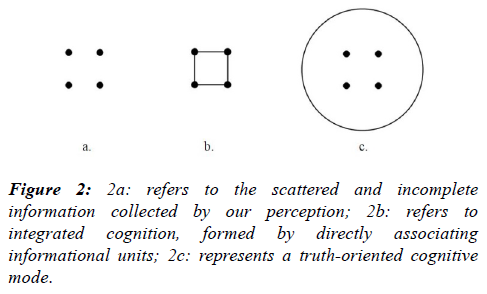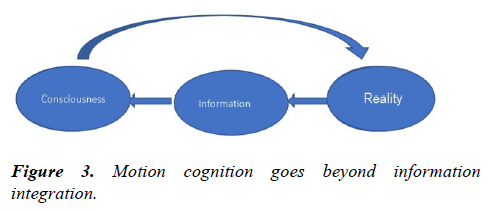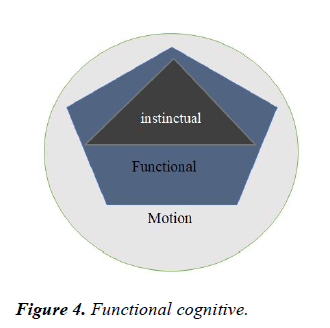Mini Review - Journal of Psychology and Cognition (2021) Volume 6, Issue 9
The journey of cognitive evolution
Aaron Peng Fu*Department of Psychology, Peng Fu Ocean University, Shanghai, China
- *Corresponding Author:
- Dr. Aaron Peng Fu
Department of Psychology
Peng Fu Ocean University
Shanghai, China
E-mail: Aaronfu@afvisionary.com
Accepted on 06 August, 2021
Citation: Peng Fu A. The journey of cognitive evolution. J Psychol Cognition 2021;6(8):1-2.
Abstract
Throughout the development of modern science, increasingly complex data and logical models have gradually replaced the direct knowledge of nature motion and reality. During the journey of discovering natural truths, it often seems as though there is no possibility to recognize and break through the cognitive chaos without further complicating the problem. However, our current cognition represents a specific cognitive stage, with fixed cognitive models. We are inside of this limited cognitive zone without a complete picture of the foundational principles or the continuous developmental path of cognition. Without the cognitive basis of motion reality, this will inevitably result in the increasingly intensified conflict between the development of human social practice and the natural motion environment. Therefore, this research focuses on exploring the roots of human cognition and it’s track of development is a new angle allowing for a breakthrough of certain cognitive dilemmas
Keywords
Cognitive evolution, Cognitive limitation.
Introduction
Human cognitive activities are the results of a process of interaction between consciousness and information. During the cognitive process, consciousness is the subject of our cognition, and information is the object or the reference of the object. Consciousness first needs to have certain vitality, in order to activate cognition. The development and advancement of cognitive modes are fundamentally driven by the activity and the level of consciousness ability from low to high. The development of active consciousness can be divided into different stages (primary, intermediate and advanced) which correspond to the periodic stages of our cognition.
In each cognitive stage a cognitive pattern matching the characteristics of that stage will emerge. First, the development of consciousness must have gone through an inactive stage. During this phase, consciousness was inert and cognitive activities were passive; consciousness activities were only stimulated and oriented by instinct to support basic survival needs [1].
The driving force of cognitive development is the development of consciousness activity. Throughout the history of biological evolution, the development of human consciousness had reached the bottleneck of instinctive cognition. At this time, only the formation of a new cognitive motivation and demand, in other words, a new cognitive orientation besides instinct could support the further development of consciousness activities. However, the instinct oriented cognitive mode can’t promote this cognitive advancement. Due to such contradictory factors, breakthrough is difficult and accidental.
Literature Review
Only humans have broken through the limits of instinctive cognition to enter the intermediate cognitive stage, so far as we are aware. At this stage consciousness became active and a new cognitive orientation developed. A qualitative change in activity occurs when moving from the primary to intermediate stage of conscious activity. This represents a change in overall trend of activity, from passive reactivity to cognitive initiation. This is a cognitive stage in which consciousness creates cognition by actively associating information. For example, through integrating dispersed bits of information and experiences regarding apples, such as "round”, “crunchy”, “eat”, “red” and “sweet", we structure a sentence that relates a concept that apples can be eaten and red apples are sweet. Integrated cognition is a functionally oriented cognition, as the cognitive form is integrated with a specific structure to realize certain functions and meet specific needs. This cognitive model functions through consciousness actively associating and integrating information, and thus can be called integrated cognition [2]. The functionally-oriented integrated cognitive mode is the dominant mode at this stage.
During this intermediate cognitive interval, the integrated cognitive pattern also goes through a developmental process from simple integration to complex integration coinciding with the increasing of consciousness activity. Throughout this process, the development of the mechanism of logic plays a crucial role. Logic is an information association mechanism, formed to construct and improve functional cognition. The logical mechanism is the concomitant mechanism of integrated cognitive development. Therefore, highly developed integrated cognition can also be considered integrated logic cognition.
Within the integrated cognitive mode, the collected information itself is scattered, discontinuous, and incomplete. Therefore, directly piecing the information together won’t restore the true form of the object, but will, rather, replace them. During this process, information is the component used to structure the integrated form for cognition. The original objects that information was associated with becomes replaced by this integrated from. In this way, a barrier is created between cognition and the reality of motion, within the integrated cognition (Figure 1).
Thus, integrated cognition is based on a function-oriented mechanism which is, at the same time, blocking the path to further understanding of the true form of the object. For example, sensory forms are integrated by interactive features which have replaced the true motion form of reality. It supports functional cognitive needs but also blocks the awareness of the existence of motion features and mechanisms, forcing us to discover motion through integrated information.
During the earlier stage of active cognition, consciousness was still weak. Associating informational units to structure the functional cognition was only possible in short moves. Therefore, this is the cognitive model that matches the consciousness stage which has active but limited mobilities. However, when the conscious activity starts to carry out more continuous mobilities, the integrated cognitive model eventually becomes a restriction. The consciousness activities are limited to a certain active zone due to the integrated cognitive mode. During the process of information association and integration, the consciousness activities are also segmented by information units.
When consciousness is weak, it is unable to reach beyond the information, so the integrations become, instead, a replacement for the true object, rather than mere reference points. Integrated cognition can be considered a transitional stage towards the development of humanity’s active cognition. After this stage, instead of directly associating information, more complete and continuous consciousness activity will enable the discovery of the truth behind the information (Figure 2).
From Figure 2a to Figure 2b, there is a qualitative increase in consciousness activity and the integrated cognitive barrier has been avoided. This represents an upgrade in the cognitive mode from integrated to the motion form [3]. Increased development while immersed within the integrated form will lead to a more complex integrated structure and limit the expansion of consciousness. Therefore, to complete this transformation requires a complete breakthrough in cognitive mode and an evolution of the cognitive form.
Just as the cognition formed through information integration is integrated in form, the cognition formed through continuous motion of consciousness is a motion form, which can directly cognize motion. With the reference of perceptual information, the cognition of the motion forms, features, and laws that lay beyond the abilities of integrated cognition, but exist in reality can be restored through the complete and continuous movement of consciousness (Figure 3).
What is essential for cognizing motion is the constant action of consciousness, which restores the motion features and offers further understanding of motion laws during its own continuous movement. Within motion cognition, if you manage to keep the cognitive process like a smooth and constant mind stretch, rather than abstract logical thinking and data analysis, you are about on the right track.
To apply the motion cognition mode towards understanding natural motion, there is a need to first clarify that we can replace reality with a patchwork of integrated models, but they do not have the characteristics and mechanisms of motion. The mode of practice reveals the underlying cognitive principles and limits [4]. This can be seen in the differences between artificial mechanically integrated structures and a naturally occurring biological motion system.
The course of cognitive development and evolution
The cognitive development of the human stage is the superimposed extension of the cognitive model. After each cognitive upgrade, the more advanced cognitive model supports not only the development of new cognitive and practical fields, but it also provides a new perspective and supportive frame for the lower-level cognitive model. For example, in the stage of functional cognition, human beings still have the ability of instinctive cognition and even more, the development of functional cognition can better creatively support and meet instinctual needs. Similarly, in the stage of motion cognition, human beings will avoid the limitations of functional cognition and develop a wholly new cognitive field. At the same time, this will provide a broad motion perspective and a reliable realistic foundation for the further development of functional cognition. The natural development and progression of human cognition leads towards a more complete cognitive mode and perspective (Figure 4).
The driving force of cognitive development is the development of consciousness. Currently, this development has driven us to the end of the functional stage of cognition, after missing the natural window for another cognitive breakthrough. The clear sign of that window was the emergence of a new cognitive orientation, one of free thinking and a human obsession with discovery of the universal truths. This was a sign of the increase of consciousness activity, as it tried to break through the restrictions of the integrated cognitive barrier. However, the increase in consciousness activity has been, instead, utilized to promote the integrated cognitive model towards increasingly complex and developed forms.
However, there is a contradictory factor for this periodic cognitive upgrade as well. The development of integrated cognition will create restrictions for further development of consciousness. The more complex the cognitive structure and denser the information integration, the more segmentation and compression of the conscious activity there will be. Continuing down this path, the probability of achieving cognitive upgrade is getting smaller and smaller, leading us down the track of cognitive evolution failure. This is not simply a delay in cognitive upgrading, but shows a complete divorce from the task of cognitive development.
The formation of the motion cognitive form is like a tree, or life; it exists in the continuous development of motion. The integrated cognition is like a structured machine. When we miss the cognitive evolution, we harvest the creation of digital and mechanical technology but miss the truth of nature and life.
Within scientific study and technological development, the facts based on interactive experiments are regarded as scientific knowledge with a realistic basis. This is inaccurate. Due to the existence of cognitive barriers, although our interaction with reality and functional creation are effective, we don’t understand the true form of reality and the real influence human practice has had on the world around us. This point is very obvious from the macro perspective of the development of modern society: functional development is unprecedentedly successful, yet, at the same time, the destruction of our living reality is also unprecedented and unexpected.
During this recent period of human history, the rapid acceleration of functional development has been lacking a basis in motion reality. Humans are led by the vision of a freed mind and the pursuit of truth. However, we remain solidly trapped within the functional cognitive mode with limits and increasingly complex barriers
The historical crisis of human development
The development of cognition continues to deviate from the main track. That is the cause of the current predicament of human development. It is still possible to adjust the course, though the hour is late and much damage has already been done.
It needs to be made clear that the evolutionary path of human cognition is not to continuously develop purely functional cognition, but rather lies in the breakthrough and upgrading of the cognitive mode which can realize motion and reality cognition.
Motion cognition can the repair the defects of functional cognition and allow for escape from the dilemmas caused by blind development divorced from reality and a base of motion.
When we understand the true causes of our failures and dilemmas, the way out is clear, and that is to return to track of cognitive development and evolution.
Motion cognition is dominated by the continuous movement of consciousness. Therefore, it is cognition with motion form and contains no bottleneck within the cognitive development. It is the final stage of development of human cognition.
Conclusion
Cognizing motion is just the basic application. The cognitive model will ultimately determine the social model. It will transform human society from one of functional orientation to one that is motion and reality-oriented.
This will allow society to enter an advanced stage of human civilization development [5]. In this stage, creation with motion and reality foundation will be developed and human society will begin to maintain coordination and sustainability with the natural motion environment.
References
- Peng Fu A. Sense and Motion: The barrier preventing us from understanding motion. Adv Phys. 2019;16:372-76.
- Peng Fu A. The motion beyond sense towards cognitive evolution and unified laws of motion. Adv Phys. 2020;17:92-100.
- Richard MR. Control and information in the intrapersonal sphere: An extension of cognitive evaluation theory. J Pers Soc Psychol. 1982;43:450.
- Amy R, Feinberg R. Cognitive evaluation theory: A meta- analytic review of the literature. Social behavior and personality. Int j. 1988;16:147-64.
- Montoya RM, Robert SH. On the importance of cognitive evaluation as a determinant of interpersonal attraction. J Pers Soc Psychol. 2004;86:696.



